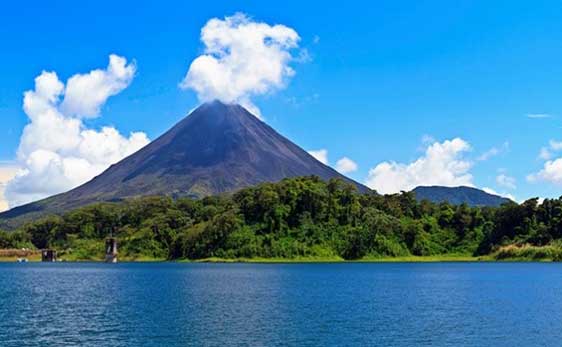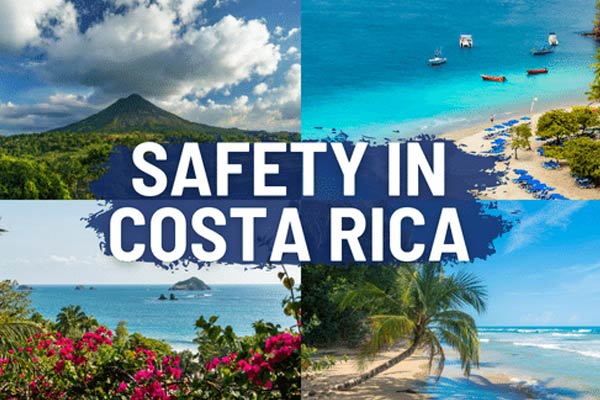Climate in Costa Rica - Costa Rica Weather is Notorious as Tropical
By Bekah Bottone
Costa Rica is a land of outstanding natural beauty—lush rainforests, undiscovered beaches, enchanting mountain villages, and majestic volcanos riddle the landscape. Situated between the Tropics of Cancer and Capricorn, its location generates diverse weather patterns across the country, creating an array of microclimates within its small area.
To fully understand the weather in Costa Rica, it’s vital to research the specific regions you plan to visit so you can pack appropriately.
Costa Rica boasts a myriad of micro and macro climates that govern the country and allows such diverse climates to thrive. For example, consider the contrasting conditionals located around Lake Arenal. On one side, in Tronadora, there is about 50% less rain than just across the lake in the lively expat town of Nuevo Arenal.
Additionally, Tronadora experiences noticeably stronger winds. It’s a noticeably distinct shift in the weather for two towns only a few minutes apart via jet ski across the lake! And as you get closer to La Fortuna from Nuevo Arenal, the vegetation transforms into a more tropical environment, as you see bamboo lining the roads.
Costa Rica is characterized by dry and wet seasons. The dry season, verano ( summer), spans from early December to April. The other season is invierno (winter), which lasts from May to November.
It’s worth mentioning that September and October tend to be the rainiest time, so I recommend visiting drier months. Of course, during these months, you could just head to the Caribbean coast for their more favorable (i.e., drier) weather. Also, keep in mind that the Caribbean and South Pacific have rainier conditions year-round.
If you’re pondering the life-changing question, ‘Where should I live in Costa Rica?’, it’s up to you to explore the diverse regions to discover which aligns most with your needs and desires.
Regional Differences

As Costa Rica lies close to the equator, daylight blankets the country for 12 hours each day, with sunrise beginning between 5:15 am and 6 am throughout the year. The sun sets between 5:40 pm and 6:30 pm, much earlier than the extended daylight hours people in the U.S. and Canada cherish during the summer months.
Costa Rica has various regions, and many have similar climatic traits. When considering spending time in Costa Rica, it’s essential to discover which area fits your needs best. As a tropical beach girl, I thrive in the hot and humid beach weather, yet enjoy the seasonal shifts between dry and wet seasons in Guanacaste.
1. North Pacific Coast: The Gold Coast and the Nicoya Peninsula – Guanacaste
Includes:
- Liberia
- Tamarindo
- Playas del Coco
- Rincón de la Vieja
- Montezuma
Costa Rica’s northernmost area is noted for its flat, forested lowlands, and hot weather. It’s important to note that Guanacaste is the country’s driest province, which means some issues regarding a lack of water at certain times of the year, particularly in places such as Tamarindo.
The hottest period of the year stretches from March-May before the rains start, and the wettest months are September and October. The Papagayo winds, which can be as strong as 70 mph, blow from December-March and are referred to as los vientos navideños (the Christmas winds) as they signify the start of the Christmas season.
[costa_rica_signup]
2. Northern Zone Lowlands
Includes:
- Arenal
- La Fortuna
- the Sarapiqui Valley in the broad flatlands
The Caribbean and its trade winds influence this region. You can enjoy its rainforests along with high daytime temperatures and cooler nights. Living options at higher elevations tend to be cooler during the day and less humid.
Arenal is an example of a microclimate, as the weather is noticeably different depending on where you are around the lake. When considering this area, visit La Fortuna, Nuevo Arenal, and Tronadora to get a feel for the different parts of the lake.
3. Monteverde Cloud Forest
Includes:
- Monteverde and its surrounding area
The cloud forest, which sits at a higher elevation than a rainforest, is a uniquely different occurrence. The daily cloud blanket produces water that drips off the foliage, feeding the vibrant green undergrowth. January-May is the dry season, while June-December is the rainy season.
This rural mountainous area is part of the Tilarán Mountains of Costa Rica, and most people reside in Santa Elena.
4. Central Valley
Includes:
The central highlands boast a mild climate with warm temperatures during the day and cooling down at night. The convenience of shopping, mild temperatures, and access to the best healthcare make the Central Valley popular with expats, especially retired ones.
The beauty of lush mountains enclosing the Central Valley is stunning, and one can find plenty of options to live surrounded by nature or in a contrasting urban city setting.
5. Central Pacific Coast
Includes:
- Jacó
- Manuel Antonio
- Quepos
These coastal lowlands are hot and humid with rainforests. Manuel Antonio is home to various reptiles, monkeys, and sloths.
This part of Costa Rica has a more intense rainy season than Guanacaste, with its dry season running from January to March, creating a more humid climate.
6. South Pacific and Southern Zone
Includes:
The South Pacific coast lowlands contain rainforests and are generally hot and humid. December through April are the driest times here, yet it’s wetter than the bordering Central Pacific zone.
Continuing down the coast, you will find many pristine beaches. Once you end up in the Osa, you enjoy that dense jungle life butting right up to the Pacific coast. Nowadays, Golfito is teeming with tourism development as it invests in its growth.
7. Caribbean Coast
Includes:
- Puerto Viejo de Talamanca
- Limón
- Tortuguero
This area contains stunning Caribbean beaches and coastal flatlands that are always warm and wet for eight months of the year. Experienced surfers may long to surf Salsa Brava, the biggest break in the country, which breaks best during their dry season (November to April).
This area’s seasons differ a bit from the rest of Costa Rica. February, March, September, and October are dry, while the other parts of Costa Rica experience heavier rains in September and October.
Average Temperatures

Due to Costa Rica’s proximity to the equator, seasonal changes are not as evident. Therefore, four distinct seasons do not occur as they do in the U.S. and Canada.
The Ocean trade winds, including the Caribbean alisios and the southwest Pacific Papagayo winds, are affected and guided by things like El Niño (causing drier and hotter weather on the Pacific coast), La Niña (causing wetter weather), and Atlantic tropical storms.
That said, the temperatures stay consistent throughout the year, with an average of 80 F to 90 F on the coasts and 70 F to 80 F on the mountainsides and the countryside. Ticos refer to the seasons based on rainfall instead of temperature, calling the dry season summer and the rainy season winter, establishing the naming of the season by rainfall amount, not the temperature.
Rainfall

The glorious rain in Costa Rica allows the vegetation to be lush… the energy that radiates from vibrant greenness is intense, in a good way! The average rainfall is 100 inches yearly, yet some places get more. For example, the Caribbean coast gets around 138 inches yearly, while the South Pacific coast gets almost 200 inches of rain annually.
There is no monsoon season in Costa Rica. However, when you look at the daily weather, it seems like it will rain all day, every day, with no hope for beach days, especially during the peak rainy season from mid-September into the start of November. And it just might rain every day… but it often only lasts for a short time, 10 minutes or a couple of hours.
No matter where you are, I advise enjoying nature when the sun is out during the rainy season. Therefore, if you wake up and it is sunny in the morning in the Costa Rican invierno, winter, head to the beach first thing. Then if it clouds up or rains later in the day, you can spend the afternoon napping or lounging in your hammock with a good book.
And sometimes it just rains all night, allowing me to relax to the actual sound of rain and not some recording while laying comfy in bed.
Even though the season’s first rains start in May, veranillo is when the land dries out a bit, especially in Guanacaste. You get lower chances of rain along with the bright green vibrancy radiating from the vegetation due to the earlier rains.
Hurricanes and Natural Disasters
Although there are occasional natural disasters and the potential of being affected by hurricanes, Costa Rica experiences a low occurrence of severe weather outside torrential downpours, which often cause flooding.
The warm temperatures of the Caribbean Sea create the perfect environment for hurricanes. Luckily, Costa Rica is located under the hurricane belt.
In addition, there’s a unique feature about the ‘spine’ of Costa Rica, mountain formations that resemble a backbone supporting the country. From the dormant Orosí Volcano near the Nicaraguan border down to the Cerro Chirripó, there is a straight line of volcanoes (some active while others are extinct or dormant) running about 270 miles. These formations, ranging from 6,000 to almost 11,000 feet above sea level, form a barrier between the two sea-level coasts.
Fortunately, this wall-like mountainous system disturbs airflow patterns and often blocks hurricanes that end up further down south, rather than passing over Costa Rica’s Caribbean coast. These mountains often create a ‘shield’ where storms that appear to directly hit Costa Rica usually bounce off this invisible barrier of cooler air and head north.
A part of the Pacific Ring of Fire, Costa Rica is no stranger to seismic activity and earthquakes in the country. There are often earthquakes in Costa Rica, but thankfully, most don’t cause damage, and in fact, I usually don’t feel them, so they never stress me out.
[costa_rica_signup]
Outdoor Activities

Since the weather is warm year-round, outdoor living is a massive draw for those who decide to reside in the country.
The beauty of the dry season in Guanacaste is that you don’t need to make rain plans, and every day is a beach or pool day! Yet this also means it gets super dusty and hot. Once I can’t stand the heat and dryness anymore, the glorious rain starts in May. And then, once I feel water-logged towards the end of the rainy season and a musty smell invades my home (watch out for mold during this time of year if you don’t use air conditioning or a dehumidifier), we start to feel the shift into dry season in November. In my opinion, it’s a cycle that balances itself out perfectly.
Raining all day, every day is not always the norm, even in the green season. Throughout the country, you may only get a few showers or hours of rain during the day. That means plenty of time to be outside in the fresh air. Additionally, it’s warm outside when it rains in many areas, making it more enjoyable and easier to handle.
Surfing is one of Costa Rica’s most popular pastimes. The wind plays a significant role in surf conditions throughout the country, and powerful swells make for some great waves. For example, in Tamarindo, we get waves all year long, but during the dry season, we sometimes get northwest swells that send perfect waves in our direction.
Clothing and Gear
When packing your bags for Costa Rica, fill them appropriately for the region and time of year. Make sure to pack sunscreen, a hat, and sunglasses, as the sun is often out for at least part of the day. Sunscreen is expensive in Costa Rica, so bring down what you need in your checked luggage. Swimsuits, sundresses, shorts, and tanktops are appropriate for casual beach living. A waterproof camera or phone case allows you to get great action shots while out in the water.
Of course, you may want to wear pants or long sleeves in higher elevations, especially in the early morning or at night. Dressing in layers is a good idea when traveling in high altitude sites like Monteverde. Also, more clothing can protect you from bug bites. Bring some mosquito repellent, as it’s also pricey down here.
If you plan on exploring the jungles, rainforests, and cloud forests, pack binoculars and hiking boots… ideally an already broken-in pair. In addition, you might want to add a waterproof bag if you plan on exploring some of the many waterfalls in the country. You can swim in some, like La Leona near Rincón de la Vieja. However, others are in protected areas, such as Rio Celeste near Volcán Tenorio.
Bring a rain jacket or poncho if traveling during the rainy season. I prefer traveling with my GORE-TEX jacket, which keeps me dry in heavy downpours. A travel umbrella and quick-drying clothing are always a good idea in the green season.
Costa Rica is an enticing paradise where you can enjoy the thick jungle, a quiet life on a mountainside, or lots of activity in the bustling city. You get to decide which is right for you.
Costa Rica’s pleasant year-round temperatures are consistent and comfortable, which appeals to many expats. Another draw is Costa Rica’s commitment to environmental conservation and sustainability, making it an attractive destination for those wanting to support sustainable practices.
Living in Costa Rica means adapting to its tropical and subtropical features. Although Costa Rica enjoys a wet and dry season, residents and visitors enjoy outdoor activities year-round. With easy access to the natural world, including pristine beaches, diverse wildlife visible outside of national parks, and lush rainforests, you also can be close to modern conveniences and good healthcare in Costa Rica. Most people prioritize their connection with nature while becoming part of a new community living in Costa Rica. Does this sound like the life you desire? If so, I will soon see you on a local beach at sunset, rain or shine!
Featured Image Copyright: ©Lightphoto/iStock
[costa-rica-website-affinity]




